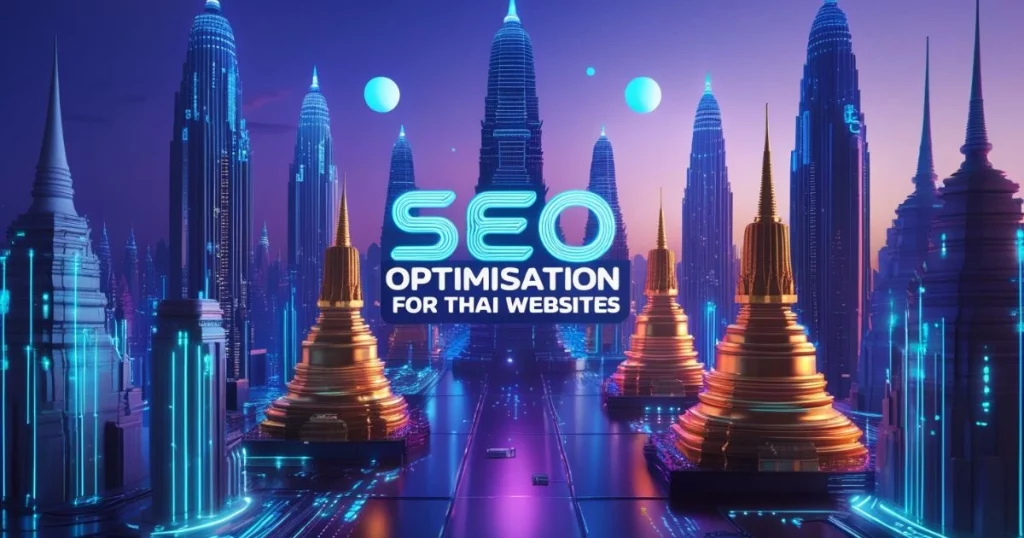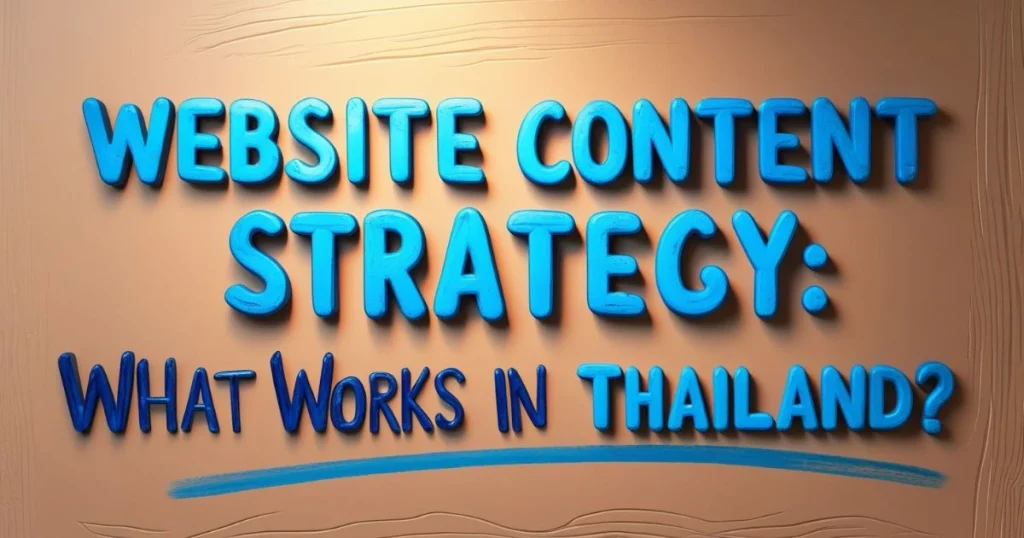You’ve finally launched your dream business in Thailand. Your product is top-notch, your pricing is competitive, and your marketing plan is solid. But as the weeks pass, your website isn’t bringing in leads. Traffic is low, visitors leave within seconds, and conversions are almost nonexistent. What went wrong?
In today’s digital-first world, your website is more than just an online brochure—it’s your most powerful sales tool. A well-designed, high-converting website doesn’t just look good; it builds trust, guides visitors towards taking action, and ultimately boosts revenue.
Why Web Design is Crucial for Thai Businesses

Thailand has one of the most vibrant digital markets in Southeast Asia. With over 85% of the population actively using the internet and more than 58 million mobile users, your potential customers are searching for products and services online daily. But here’s the catch: Thai consumers expect a seamless and engaging web experience.
If your website loads slowly, isn’t mobile-friendly, or lacks clear call-to-actions, you’re losing customers before they even get a chance to explore what you offer. Studies show that 88% of users won’t return to a site after a bad experience, and with high competition in nearly every industry, first impressions matter more than ever.
Understanding Thai Consumer Behaviour Online
Thai consumers are highly mobile-dependent, meaning your website must be optimised for smartphones first. They also place great emphasis on trust and social proof, making elements like customer reviews, testimonials, and clear payment options essential for conversions. Moreover, with a preference for visually rich content, Thai audiences engage more with websites that integrate high-quality images, videos, and interactive elements.
In this guide, we’ll dive deep into everything you need to know about building a high-converting website in Thailand—from choosing the right platform and optimising user experience to mastering SEO and localising your content. Let’s get started!
Understanding the Thai Digital Landscape

Thailand is one of Southeast Asia’s most digitally connected countries, making web design a crucial factor in business success. With a rapidly growing online economy, businesses that understand Thai consumer behaviour and adapt to local digital trends can gain a competitive edge.
Thailand’s Internet & Mobile Penetration
The numbers speak for themselves: Thailand has over 85% internet penetration and more than 58 million active mobile users. In fact, studies show that Thais spend an average of nine hours per day online, with a significant portion of that time dedicated to shopping, social media, and digital content consumption.
But here’s where it gets even more interesting—mobile browsing dominates. Over 75% of website traffic in Thailand comes from mobile devices, meaning that businesses must prioritise mobile-friendly, responsive web design. If a site isn’t optimised for mobile, potential customers will simply leave and choose a competitor instead.
What Thai Consumers Expect from a Website
Thai users are tech-savvy but impatient. They expect fast-loading websites (ideally under three seconds), easy navigation, and engaging visuals. A slow, cluttered, or difficult-to-use site will cause high bounce rates, which can negatively impact both SEO rankings and conversion rates.
Moreover, trust plays a huge role in online transactions. Thai consumers tend to favour websites that include:
- Social proof (customer reviews, testimonials, and ratings).
- Clear contact details (especially a local phone number and social media links).
- Local payment options (such as Thai bank transfers, PromptPay, and QR code payments).
Additionally, content that is available in both Thai and English helps businesses reach a broader audience and build credibility.
Industries That Benefit Most from Strong Web Design
A well-structured website is essential for businesses across various industries in Thailand. Some of the biggest beneficiaries include:
- E-commerce & Retail – With online shopping booming, a sleek, user-friendly e-commerce site can significantly boost sales.
- Hospitality & Tourism – Hotels, resorts, and tour companies rely heavily on high-quality web design to attract international and domestic travellers.
- Real Estate – With many foreign investors looking to buy property in Thailand, real estate websites need professional design, virtual tours, and lead generation features.
- Healthcare & Wellness – Private hospitals, clinics, and wellness centres thrive on credibility and clear information, making intuitive web design crucial.
With Thailand’s digital market constantly evolving, businesses must adapt their web design to match user expectations and industry standards. Next, let’s explore the key elements of a high-converting website and how you can apply them to your business.
Key Elements of a High-Converting Website

Building a website is one thing—turning it into a high-converting sales machine is another. In Thailand’s competitive digital landscape, businesses must focus on user experience (UX), speed, and localisation to capture and retain customers. Let’s explore the key elements that make a website truly effective.
1. Mobile-First Design for Thailand’s Mobile-Heavy Users
Thailand is a mobile-first market, with over 75% of web traffic coming from smartphones. If your site isn’t designed for mobile users, you’re losing out on a massive audience.
A mobile-friendly website should:
✅ Be fully responsive, adapting to any screen size.
✅ Have large, easy-to-tap buttons for seamless navigation.
✅ Avoid pop-ups that disrupt the mobile experience.
✅ Use a clean, minimalist design that loads quickly on mobile networks.
Google also prioritises mobile-friendly websites in search rankings, making this a critical SEO factor.
2. Fast Loading Speed & Performance Optimisation
Thai users are impatient online—if your website takes longer than three seconds to load, you’re at risk of losing visitors. A one-second delay can reduce conversions by up to 7%.
To optimise speed, ensure that your site:
🚀 Uses compressed images to reduce file sizes.
🚀 Minimises HTTP requests and unnecessary scripts.
🚀 Utilises a content delivery network (CDN) for faster load times.
🚀 Implements caching to reduce repeated loading times.
Google’s PageSpeed Insights is a great tool to test and improve site speed.
3. Clear Call-to-Actions (CTAs) to Drive Conversions
A high-converting website guides visitors towards taking action—whether that’s making a purchase, booking a service, or submitting an enquiry.
Effective CTAs should:
✅ Be clear and action-oriented (e.g., “Get a Free Quote” or “Shop Now”).
✅ Stand out visually with bold colours and prominent placement.
✅ Create urgency using phrases like “Limited Offer” or “Only 3 Spots Left!”.
✅ Be placed strategically—above the fold, at the end of sections, and within engaging content.
4. Localisation: Language, Culture & Payment Options
Thailand’s market is unique, and businesses must adapt their websites to local preferences.
🔹 Language Matters: Many Thai users prefer browsing in their native language. Having both Thai and English versions can expand your reach and increase trust.
🔹 Cultural Considerations:
- Thai audiences respond well to warm, friendly designs with vibrant colours.
- Social proof is crucial—display testimonials, influencer collaborations, and real customer experiences.
🔹 Payment Options: Trust is a major factor in online purchases. To boost conversions, include:
- Thai bank transfer options.
- PromptPay (a popular QR code payment system).
- Local e-wallets such as TrueMoney Wallet or Rabbit LINE Pay.
A website that aligns with Thai consumer habits and expectations will not only attract more visitors but also convert them into loyal customers.
Up next, we’ll explore how to choose the right website platform for your business needs.
Choosing the Right Website Platform

Selecting the right website platform is one of the most important decisions for your business. In Thailand’s competitive online market, you need a platform that aligns with your goals, whether it’s selling products, generating leads, or showcasing your services. Let’s explore the most popular options and their pros and cons.
1. WordPress – The Most Flexible Option
✅ Best for: Blogs, business websites, lead generation, and scalable e-commerce.
Pros:
- Highly customisable with thousands of themes and plugins.
- Excellent for SEO and content marketing.
- Scalable for small and large businesses.
Cons:
- Requires web hosting and regular maintenance.
- Steeper learning curve for beginners.
2. Shopify – The E-Commerce Powerhouse
✅ Best for: Online stores and dropshipping businesses.
Pros:
- Built-in e-commerce features (inventory management, secure payments).
- User-friendly with drag-and-drop design.
- Strong customer support.
Cons:
- Monthly subscription fees can be high.
- Limited customisation compared to WordPress.
3. Wix – The Beginner-Friendly Choice
✅ Best for: Small businesses, freelancers, and portfolio websites.
Pros:
- Easy-to-use drag-and-drop builder.
- No coding skills required.
- Quick setup with pre-designed templates.
Cons:
- Less flexible for advanced customisation.
- Not ideal for complex SEO strategies.
4. Custom-Coded Websites – Maximum Control
✅ Best for: Large enterprises and businesses needing unique functionality.
Pros:
- Full creative and functional control.
- Faster performance with optimised coding.
- No platform limitations.
Cons:
- Expensive and time-consuming to build.
- Requires a skilled developer for maintenance.
Which Platforms Work Best for Thai Businesses?
For most businesses in Thailand, WordPress and Shopify are the top choices. WordPress is ideal for lead-generation and content-heavy sites, while Shopify is best for e-commerce due to its built-in sales tools and Thai payment integration.
How to Choose Based on Your Needs
🔹 Want a blog or business website? → WordPress
🔹 Selling products online? → Shopify
🔹 Need a simple portfolio? → Wix
🔹 Building a large-scale, unique platform? → Custom development
Choosing the right platform sets the foundation for your online success. In the next section, we’ll dive into UX & UI best practices to create a seamless user experience.
UX & UI Design Best Practices for Thai Audiences

A beautifully designed website isn’t enough—it also needs to be user-friendly, engaging, and culturally relevant. In Thailand, where online competition is fierce, businesses must prioritise User Experience (UX) and User Interface (UI) design to keep visitors engaged and convert them into customers.
1. User-Friendly Navigation: Simplicity Wins
Thai consumers expect fast, hassle-free browsing. If your website is difficult to navigate, they’ll leave within seconds.
✅ Best Practices for UX Navigation:
- Use clear, well-labelled menus with intuitive categories.
- Keep the navigation bar simple—ideally 5-7 main menu items.
- Implement breadcrumb navigation so users know where they are.
- Make CTAs (Call-to-Actions) visible and strategically placed.
A cluttered website can be overwhelming, so aim for a clean layout with well-organised sections.
2. Colour Psychology & Visual Preferences in Thai Culture
Colours play a powerful role in influencing emotions and consumer decisions. In Thailand, colours are deeply tied to cultural beliefs and branding perceptions.
🔹 Red – Passion, energy, and excitement (often used in promotions and discounts).
🔹 Gold & Yellow – Prestige, luck, and royalty (popular for luxury brands).
🔹 Blue – Trust and reliability (used by banks, corporates, and tech brands).
🔹 Green – Health, sustainability, and nature (ideal for wellness and eco-friendly businesses).
Thai audiences also prefer visually engaging websites with:
- High-quality images and videos to showcase products/services.
- Minimalist yet vibrant designs to avoid clutter while keeping it visually appealing.
- Soft edges and rounded buttons to create a welcoming feel.
3. Designing for Trust & Credibility
Trust is one of the biggest factors in conversion rates. Thai consumers tend to be cautious when shopping or making transactions online. To build trust, your website should include:
✔ Social Proof: Customer testimonials, case studies, and Google Reviews.
✔ Trust Badges: SSL certificates, secure payment icons, and industry certifications.
✔ Live Chat & Contact Information: A visible phone number, email, and Line/WhatsApp chat boosts credibility.
✔ Local Payment Options: Displaying PromptPay, TrueMoney Wallet, and Thai bank transfers reassures users.
Additionally, featuring real images of your team, office, or happy customers adds authenticity and helps Thai consumers connect with your brand.
A website that is easy to navigate, visually appealing, and trustworthy will significantly improve conversions. Up next, we’ll dive into SEO optimisation strategies for Thai websites to drive traffic and visibility.
SEO Optimisation for Thai Websites

Having a stunning website is only half the battle—without Search Engine Optimisation (SEO), your target audience won’t find you. SEO helps businesses rank higher on search engines like Google Thailand and Pantip, increasing organic traffic and conversions.
1. The Role of SEO in Website Traffic
In Thailand, Google dominates the search market, with over 98% of users relying on it to find products, services, and information. If your website doesn’t appear on the first page of search results, you’re missing out on valuable traffic and potential customers.
SEO works by optimising your site’s content, structure, and authority to help search engines understand its relevance. The better your SEO, the higher your website ranks, leading to:
✅ Increased visibility and credibility.
✅ More organic traffic without paid ads.
✅ Higher conversion rates from relevant visitors.
2. How to Optimise for Google & Thai Search Engines
🔹 Use Thai Keywords Strategically
While English keywords are useful, many Thai consumers search in Thai. A mix of Thai and English keywords can improve visibility. For example:
- “ร้านอาหารมังสวิรัติ กรุงเทพ” (Vegetarian restaurant Bangkok)
- “เว็บดีไซน์ไทยแลนด์” (Web design Thailand)
Use Google Keyword Planner to find the best Thai search terms in your industry.
🔹 Optimise Website Speed & Mobile Performance
Since most Thai users browse on mobile, ensure:
- Fast loading times (under 3 seconds).
- Responsive design for all devices.
- AMP (Accelerated Mobile Pages) for faster mobile performance.
🔹 Create High-Quality, Localised Content
Google prioritises websites with valuable, informative content. In Thailand, the most effective content types include:
- Blog posts that answer common questions.
- Product descriptions that include Thai-specific details (e.g., prices in Thai Baht).
- Videos & infographics, as Thai users engage highly with visual content.
3. Local SEO Tactics: Google My Business, Thai Keywords & Backlinks
🔹 Claim & Optimise Your Google My Business (GMB) Listing
For local businesses, Google My Business is essential. Ensure your listing:
✅ Is fully updated with your business name, address, and phone number.
✅ Includes photos, reviews, and accurate opening hours.
✅ Uses relevant Thai keywords in the description.
🔹 Build Thai Backlinks & Local Citations
Backlinks (links from other websites to yours) boost credibility and rankings. In Thailand, effective backlink strategies include:
- Getting featured on local directories (e.g., Wongnai, Pantip).
- Partnering with Thai bloggers & influencers.
- Publishing guest posts on industry-related Thai websites.
By combining technical SEO, local optimisation, and strategic content, your website will attract more organic traffic and rank higher on search engines. Next, we’ll cover website content strategies that engage Thai audiences and drive conversions.
Website Content Strategy: What Works in Thailand?

Content is the driving force behind a high-converting website. In Thailand, where digital engagement is visual-heavy and social-driven, businesses must create content that resonates with local audiences, builds trust, and encourages action.
1. The Type of Content Thai Users Engage With
Thai consumers are highly active online, but their content preferences differ from Western markets. The most effective content formats include:
📌 Blogs & Educational Content
- Thai users appreciate informative blogs that solve real problems.
- “How-to” guides, listicles, and industry insights perform well.
- Content should be concise, engaging, and easy to scan.
📌 Videos & Live Streams
- Thailand ranks among the top countries for video consumption.
- Short-form videos (1–3 minutes) perform best on websites and social media.
- Live streaming (e.g., product demos) boosts engagement and conversions.
📌 Social Proof & Reviews
- Thai consumers trust user reviews more than brand marketing.
- Featuring customer testimonials, case studies, and influencer endorsements builds credibility.
- Integrating Facebook or LINE reviews directly onto your website increases trust.
2. How to Structure Persuasive Landing Pages
A well-structured landing page is crucial for converting visitors into customers. Thai audiences respond best to:
✅ Clear Headline & Value Proposition
- Use simple, direct language explaining why your product/service is beneficial.
- Example: “อันดับ 1 ด้านออกแบบเว็บไซต์ในไทย – สร้างเว็บที่เพิ่มยอดขายให้คุณ!” (Thailand’s #1 Web Design Experts – Build a Website That Increases Sales!)
✅ Engaging Visuals & Minimal Text
- High-quality images & videos outperform text-heavy pages.
- Bullet points and icons help keep information digestible.
✅ Strong Call-to-Action (CTA)
- CTAs should be bold, action-oriented, and culturally relevant.
- Example: “เริ่มต้นวันนี้!” (Get Started Today!) instead of generic “Sign Up”.
✅ Trust Signals & Local Relevance
- Highlight secure payment options, money-back guarantees, and real customer testimonials.
- Display localised elements (e.g., Thai baht pricing, Thai phone numbers).
3. The Importance of Bilingual Content (Thai & English)
Thailand has a diverse audience, including locals and expatriates. Offering both Thai and English content is essential for:
🌍 Expanding Reach – English appeals to international buyers; Thai resonates with locals.
📈 SEO Benefits – Targeting Thai and English keywords improves search rankings.
🤝 Building Trust – Thai users prefer businesses that communicate in their language.
For maximum impact, businesses should have:
- A language toggle on their website.
- Blog content translated professionally, not auto-generated.
- Thai-friendly UX (e.g., right font sizing for Thai script readability).
By crafting engaging, localised, and structured content, businesses can attract, retain, and convert more Thai customers. Next, we’ll explore web development and security best practices to keep your website running smoothly.
Web Development & Security Considerations

A high-converting website isn’t just about design and content—it must also be secure, legally compliant, and well-maintained. Security breaches, slow performance, or legal issues can damage your brand’s reputation and lead to lost revenue. Here’s how to keep your website safe, compliant, and optimised in Thailand.
1. Securing Your Website with SSL & Other Safety Measures
Thai consumers are cautious when making online transactions. A secure website builds trust and reduces the risk of cyber threats.
✅ SSL Certificate – Encrypts data and ensures your website uses HTTPS (Google also prioritises HTTPS sites in search rankings).
✅ Regular Security Updates – Always update your CMS (e.g., WordPress), plugins, and themes to patch vulnerabilities.
✅ Firewalls & Malware Protection – Use security plugins like Wordfence (WordPress) or Cloudflare for added protection.
✅ Secure Payment Gateways – Ensure you use trusted options like PromptPay, TrueMoney Wallet, and international payment processors (PayPal, Stripe).
2. GDPR & PDPA Compliance in Thailand
Thailand’s Personal Data Protection Act (PDPA) aligns with Europe’s GDPR laws, meaning businesses must handle customer data responsibly. Failure to comply can result in legal penalties.
🔹 What You Need to Do:
- Display a cookie consent banner to inform users of data tracking.
- Have a clear privacy policy outlining how user data is collected and stored.
- Ensure secure customer data handling, especially for e-commerce businesses.
If your website collects personal data (emails, phone numbers, payment info), compliance is a must.
3. Website Maintenance Tips
A website requires ongoing maintenance to perform well. Key tasks include:
🛠 Regular Backups – Automate backups using tools like UpdraftPlus or Jetpack.
⚡ Speed Optimisation – Compress images, use caching, and remove unnecessary plugins.
📊 Performance Monitoring – Use Google Analytics and Google Search Console to track performance and fix issues.
🔄 Content Updates – Keep product info, blog posts, and contact details fresh to improve SEO and user experience.
By securing, maintaining, and optimising your website, you’ll ensure smooth performance, legal compliance, and customer trust. Next, we’ll explore web design costs in Thailand and what to expect.
Cost of Web Design in Thailand: What to Expect

Building a professional website in Thailand can range from a few thousand baht to hundreds of thousands, depending on the complexity, design quality, and the service provider. Understanding the cost breakdown will help you choose the right option for your budget and business needs.
1. Breakdown of Pricing: Freelancers, Agencies & DIY Platforms
💻 DIY Website Builders (฿3,000 – ฿15,000 per year)
- Platforms like Wix, Shopify, and WordPress.com offer affordable options.
- Best for small businesses, startups, and personal brands.
- Pros: Low cost, easy to use, no coding required.
- Cons: Limited customisation and scalability.
👨💻 Freelance Web Designers (฿15,000 – ฿50,000 per project)
- Suitable for small to mid-sized businesses that need a custom website without agency-level costs.
- Pros: More customisation, lower costs than agencies.
- Cons: May lack ongoing support and security updates.
🏢 Web Design Agencies (฿50,000 – ฿300,000+ per project)
- Best for corporate, e-commerce, and high-traffic websites.
- Pros: Full-service solutions, including design, SEO, and maintenance.
- Cons: Higher costs, longer development timelines.
2. How to Choose a Web Design Agency in Thailand
To find the right agency, consider:
✅ Portfolio & Experience – Check past projects to ensure their design matches your vision.
✅ Client Reviews & Testimonials – Look for positive feedback and real success stories.
✅ SEO & Mobile Optimisation – Ensure they design sites that are fast, mobile-friendly, and search engine optimised.
✅ Support & Maintenance – Ask about post-launch support, security updates, and hosting services.
3. Hidden Costs to Look Out For
🚨 Domain & Hosting Fees – Some agencies don’t include these in their quotes.
🚨 Premium Plugins & Themes – Custom functionalities may require extra payments.
🚨 Ongoing Maintenance – Security updates, backups, and content updates often come at an additional cost.
Understanding these costs will help you budget effectively and avoid unexpected expenses. Next, we’ll explore real-life case studies of Thai businesses with high-converting websites.
Case Studies: Successful Thai Business Websites

For expat entrepreneurs in Thailand, a well-designed website can be the key to reaching both local and international customers. Here are three niche businesses that have leveraged smart web design to attract leads, build trust, and drive conversions.
1. The Minor Food Group – Multi-Brand Restaurant Success
Industry: Hospitality & F&B
Why It Works:
✅ Bilingual Content – English and Thai site versions cater to both locals and expats.
✅ Seamless Online Ordering – Customers can book a table or order delivery in just a few clicks.
✅ Strong Brand Storytelling – Highlights their international restaurant franchises (The Coffee Club, Benihana, etc.), appealing to expats looking for familiar dining options.
2. Serenity Yachting Pattaya – Luxury Boat Charters for Tourists & Expats
Industry: Tourism & Luxury Services
Why It Works:
✅ Visually Engaging Design – High-quality images and videos of yacht experiences.
✅ Simple Navigation & Booking – Contact details and inquiry forms are easy to find.
✅ Trust Signals – Features TripAdvisor reviews, testimonials, and pricing transparency to build credibility.
3. The Londoner Brew Pub – A Beloved Expat Hangout
Industry: Food & Beverage / Entertainment
Why It Works:
✅ Engaging Visuals – High-quality images showcasing food, drinks, and events.
✅ Easy Online Reservations – Simple booking system for tables and private events.
✅ Bilingual Content – Appeals to both local and expat customers with English and Thai options.
Key Takeaways for Expat-Owned Businesses
- Bilingual content and clear navigation help bridge the gap between Thai and foreign customers.
- Trust elements (testimonials, reviews, security badges) are essential, especially for legal and luxury services.
- Fast, mobile-friendly sites with clear CTAs make it easy for customers to take action.
By applying these strategies, expat-owned businesses in Thailand can attract more leads, increase engagement, and boost conversions.
Conclusion & Next Steps

Building a high-converting website in Thailand requires more than just an attractive design—it must be mobile-friendly, fast, SEO-optimised, and culturally adapted to meet the expectations of both Thai and expat audiences.
Key Takeaways from This Guide:
✅ Mobile-First Design is Essential – With most Thai users browsing on mobile, a responsive and fast-loading site is a must.
✅ SEO & Localisation Drive Visibility – Using Thai and English keywords, Google My Business, and local backlinks helps improve search rankings.
✅ Trust & Credibility Matter – Websites with testimonials, secure payment options, and clear service information convert better.
✅ Content & UX Influence Engagement – Bilingual content, engaging visuals, and strong CTAs guide users toward action.
✅ Choosing the Right Platform is Key – Whether WordPress, Shopify, or a custom-coded site, the platform should match your business goals.
Take Action Today
Now that you understand what makes a website successful in Thailand, it’s time to take action:
🚀 Need Expert Help? – Get a web design consultation tailored to your business needs.
💡 DIY Approach? – Start implementing these best practices today to improve conversions.
A well-designed website is one of the most powerful tools for growing your business in Thailand. Don’t let poor web design hold you back—start optimising today!
FAQs
How Much Does a Professional Website Cost in Thailand? (2025 Pricing Breakdown)
| Type | Cost (THB) | Best For |
|---|---|---|
| DIY (Wix/Shopify) | ฿3,000–฿20,000/year | Startups, simple stores |
| Freelancer | ฿20,000–฿80,000 | SMEs with basic needs |
| Mid-Tier Agency | ฿80,000–฿300,000 | SEO-ready business sites |
| Enterprise Custom | ฿300,000+ | Complex platforms |
Hidden Costs: Thai hosting, PDPA setup, AI chatbots.
Best Website Platform for Thailand in 2025? (New Trends)
- WordPress: Top for SEO + scale (60% market share).
- Shopify: PromptPay & LINE Pay support built-in.
- Webflow: No-code, plugin-free elegance.
- Headless CMS: Super-fast Next.js + Strapi builds.
- AI Builders: Tools like Dora AI generate quick sites (but need SEO tweaking).
How to Optimize for Thai SEO in 2025 (Beyond Basics)
- ✅ Voice SEO: Target Thai queries like “ร้านทำเว็บดีๆ ที่ไหนบ้าง”.
- ✅ Local Backlinks: Pantip, Wongnai, Thai blogs.
- ✅ Speed: Use Thai CDNs (e.g., Bunny.net) for <1.5s loads.
- ✅ AI Filters: Always human-edit Thai AI drafts for slang & nuance.
Do You Need a Bilingual Website? (2025 Data)
- Yes: 55% of Thais prefer Thai + English toggles.
- Design Tip: Use Thai fonts like Sarabun for legibility.
- SEO Boost: Implement hreflang tags for Thai/English versions.
- Budget Hack: Try Weglot (฿1,500/month) + human proofreading.
Must-Know Security & Legal Rules (2025 Update)
- 🔒 SSL: Mandatory—use Let’s Encrypt.
- 🛡 PDPA: Cookie banners in Thai, encrypted forms.
- 💳 eCommerce Law: Show biz license on sales sites.
- ⚙️ Tools: Termly.io for policy compliance (฿800/month).
2025’s Biggest Web Design Trends in Thailand
- ✅ AI-Personalization (auto language, content shift)
- ✅ 3D/AR Integration (virtual try-ons)
- ✅ Dark Mode Default (70% Thai preference)
- ✅ Zero-Click SEO (schema for Google AI answers)
Case Study: Bangkok spa grew bookings 180% by adding a LINE booking widget + Thai toggle.
Bonus: DM “WEB2025” for a free site consultation!


